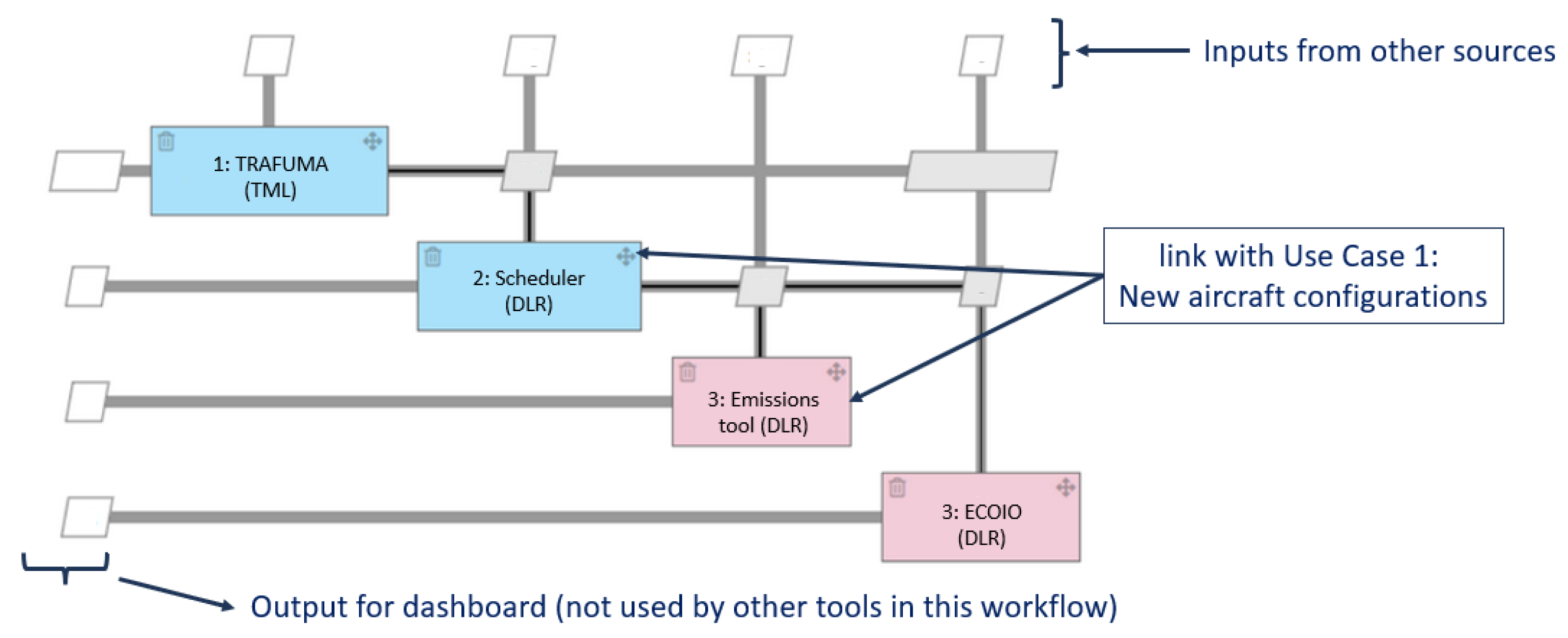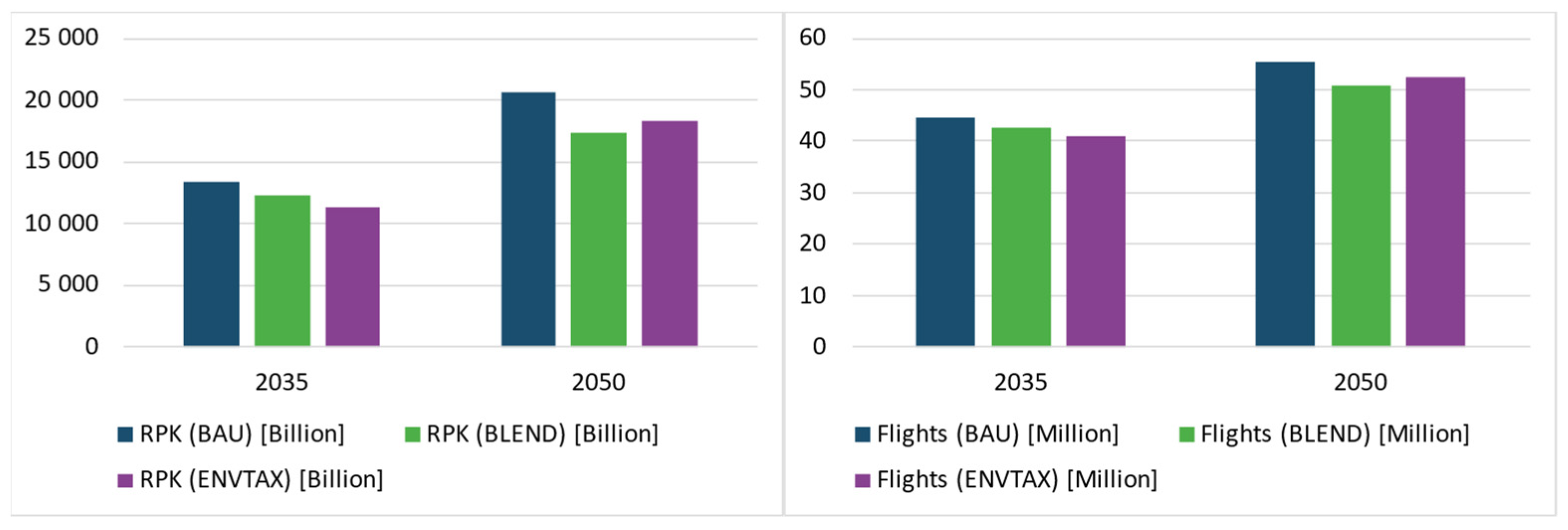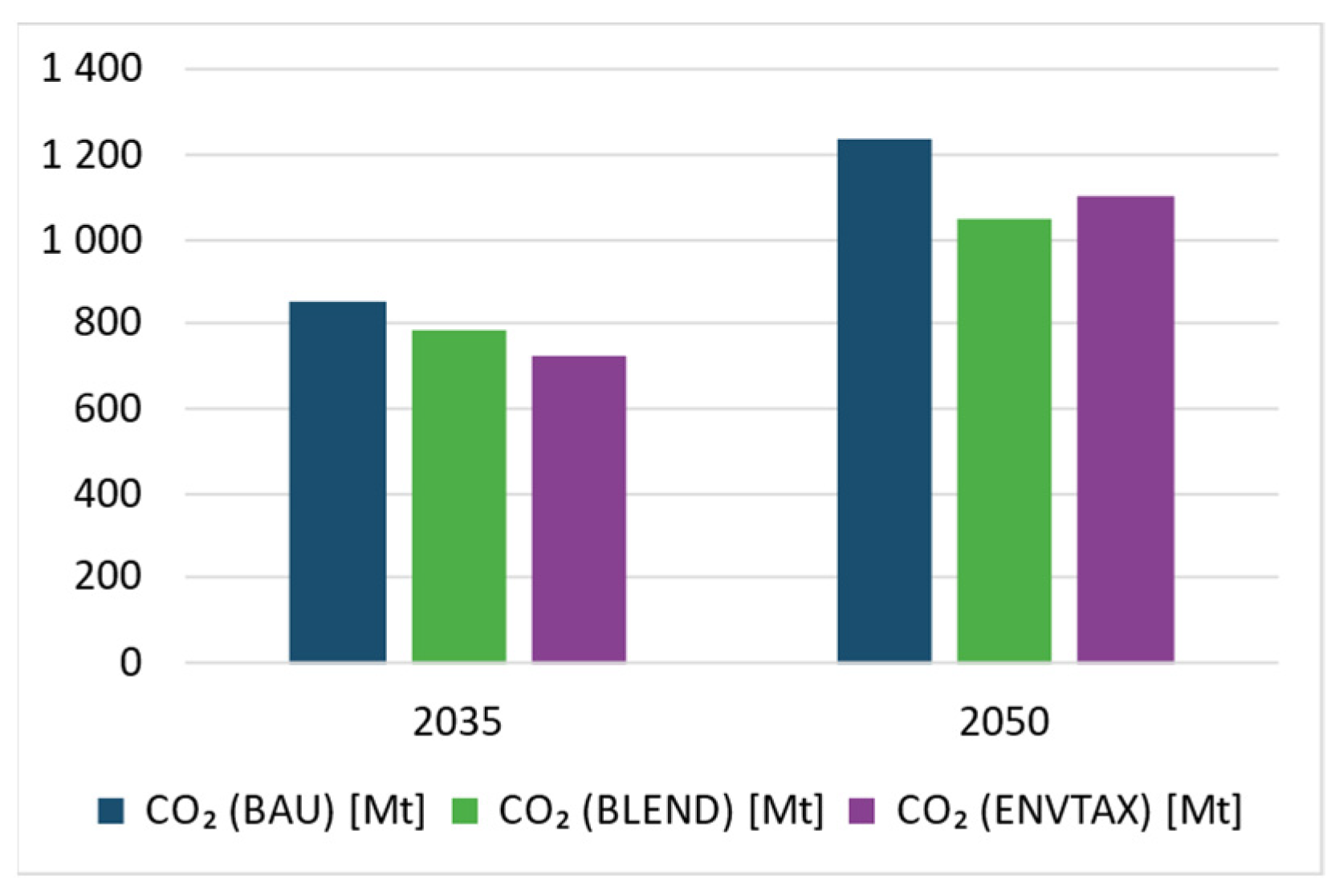Assessing Policies for the Uptake of Sustainable Aviation Fuels Using the Impact Monitor Framework †
Abstract
:1. Introduction
2. Technical Implementation
2.1. Workflow
2.2. Integration of the Tools in CPACS, RCE and the Dashboard Application
3. Demonstration Exercise: Scenarios for the Uptake of Sustainable Aviation Fuels
3.1. Scenario Definition: Reference Scenario and Two Policy Scenarios
- The tax levels in 2015 (assumed to remain constant in real terms).
- Aviation has to surrender ETS emission allowances for the CO2 emissions of flights within and between the countries of the European Economic Area (EEA), Switzerland and the UK. Maritime transport is covered by the ETS. In addition, the EU ETS2 applies, with road transport as one of the sectors covered. The future price of the emission allowances in the EU ETS and EU ETS2 is taken to be 200 EUR/tonne CO2.
- The EU CO2 emission performance standards for road vehicles apply. In combination with the EU ETS2, this leads to an important electrification of road transport, and a substantial decrease in the non-electric fuel demand of the sector in 2035 and 2050 compared to now.
- Policies regarding renewable energy:
- o
- For non-European countries, the share of renewable fuels in the transport sector is based on the “stated policies” scenario of the IEA [7].
- o
- For the EU in 2035, a policy similar to the Renewable Energy Directive III is assumed to apply in the reference scenario, with a target share of 60% for transport. The multipliers and constraints on the fuels allowed are the same as in the REDIII.
- o
- For the EU in 2050, a renewable energy share of 90% is assumed for road transport.
- o
- The share of renewables in electricity generation is taken to be 77% in 2035 and 89% in 2050 (scenario S1 of [8]).
- SC_blending: a blending mandate is introduced for aviation and maritime transport.
- o
- Aviation: For the EU, this scenario is broadly in line with REFuelEU Aviation: 20% SAF in 2035 and 70% SAF in 2050; for the fuels bought in the EU, a minimum share of renewable fuels of non-biological origin (RFNBO) applies: 5% in 2035 and 70% in 2050. No food- and feed-based fuels can be used in aviation. For the rest of the world, the overall blending mandate is similar, but no sub-mandate is assumed to apply for RFNBO.
- o
- Maritime transport: for fuels bought in the EU, the scenario imposes a blending mandate of 25% in 2035 and 90% in 2050.
- SC_ENVTAX: an environmental tax is levied on aviation fuels in 2035 and 2050, depending on the WTW with ILUC CO2eq emission factors. The tax is assumed to equal 200 EUR/tonne CO2eq. In this scenario, aviation is no longer included in the European emission trading systems.
3.2. Tool Parameters
3.3. Scenario Results
4. Concluding Remarks
Author Contributions
Funding
Institutional Review Board Statement
Informed Consent Statement
Data Availability Statement
Acknowledgments
Conflicts of Interest
References
- Prakasha, P.S.; Ratei, P.; van Eenige, M.; Solazzo, M.A.; Alder, M.; Riaz, A.; Gupta, U.; Lefebvre, T.; Nagel, B. Impact Monitor EU Project—Overview and Approach. In Proceedings of the 34th Congress of the International Council of the Aeronautical Sciences, ICAS 2024, Florence, Italy, 9–13 September 2024. [Google Scholar]
- van Eenige, M. Toolbox, Practical Guidance for Complete Cycle of Holistic Impact Assessments of European Aviation R&I. Deliverable 1.2 of the Impact Monitor project, 2025, forthcoming. Available online: https://impactmonitor.eu/dissemination/public-deliverables (accessed on 12 March 2025).
- Alder, M.; Ratei, P.; Prakash, P.S.; Riaz, A.; Lefebvre, T. Impact Monitor Framework—Development and Implementation of a Collaborative Framework for Aviation Impact Assessment. Eng. Proc. 2025, 90, 61. [Google Scholar] [CrossRef]
- Linke, F.; Grewe, V.; Gollnick, V. The Implications of Intermediate Stop Operations on Aviation Emissions and Climate. Meteorologische Zeitschrift 2017, 26, 697–709. [Google Scholar] [CrossRef]
- Zengerling, Z.L.; Linke, F.; Weder, C.M.; Dahlmann, K. Climate-Optimised Intermediate Stop Operations: Mitigation Potential and Differences from Fuel-Optimised Configuration. Appl. Sci. 2022, 12, 12499. [Google Scholar] [CrossRef]
- Gupta, U.; Riaz, A.; Brenner, F.; Lefebvre, T.; Ratei, P.; Alder, M.; Prakasha, P.S.; Pons-Prat, J.; Markatos, D. Assessing advanced propulsion systems using the Impact Monitor Framework. In Proceedings of the 14th EASN Conference, Thessaloniki, Greece, 8–11 October 2024. [Google Scholar]
- IEA. World Energy Outlook 2023; IEA: Paris, France, 2023. [Google Scholar]
- EC. Impact Assessment Report Accompanying the Communication of the European Commission to the European Parliament, the Council, the European Economic and Social Committee and the Committee of the Regions. Securing Our Future. Europe’s 2040 Climate Target and Path to Climate Neutrality by 2050 Building a Sustainable, Just and Prosperous Society; SWD (2024) 63 final; European Commission: Strasbourg, France, 2024. [Google Scholar]
- Clean Aviation Joint Undertaking. Technology Evaluator Clean Sky 2: Second Global Assessment 2024; Technical Report; Clean Sky Joint Undertaking: Brussels, Belgium, 2024; pp. 1–239. [Google Scholar]
- Mayeres, I.; Proost, S.; Delhaye, E.; Novelli, P.; Conijn, S.; Gómez-Jiménez, I.; Rivas-Brousse, D. Climate ambitions for European aviation: Where can sustainable aviation fuels bring us? Energy Policy 2023, 175, 113502. [Google Scholar] [CrossRef]
- Gelhausen, M.C.; Berster, P.; Wilken, D. Airport Capacity Constraints and Strategies for Mitigation: A Global Perspective, 1st ed.; Elsevier: Amsterdam, The Netherlands; Academic Press: Cambridge, MA, USA, 2019; pp. 1–338. [Google Scholar]
- Gelhausen, M.C.; Grimme, W.; Junior, A.; Christos, L.; Berster, P. Clean Sky 2 Technology Evaluator—Results of the First Air Transport System Level Assessments. Aerospace 2022, 9, 204. [Google Scholar] [CrossRef]









Disclaimer/Publisher’s Note: The statements, opinions and data contained in all publications are solely those of the individual author(s) and contributor(s) and not of MDPI and/or the editor(s). MDPI and/or the editor(s) disclaim responsibility for any injury to people or property resulting from any ideas, methods, instructions or products referred to in the content. |
© 2025 by the authors. Licensee MDPI, Basel, Switzerland. This article is an open access article distributed under the terms and conditions of the Creative Commons Attribution (CC BY) license (https://creativecommons.org/licenses/by/4.0/).
Share and Cite
Mayeres, I.; Peduzzi, E.; Alder, M.; Baier, F.; Buchtal, K.; Chatterjee, S.; Clococeanu, M.; Ennen, D.; Gelhausen, M.; Junior, A.; et al. Assessing Policies for the Uptake of Sustainable Aviation Fuels Using the Impact Monitor Framework. Eng. Proc. 2025, 90, 95. https://doi.org/10.3390/engproc2025090095
Mayeres I, Peduzzi E, Alder M, Baier F, Buchtal K, Chatterjee S, Clococeanu M, Ennen D, Gelhausen M, Junior A, et al. Assessing Policies for the Uptake of Sustainable Aviation Fuels Using the Impact Monitor Framework. Engineering Proceedings. 2025; 90(1):95. https://doi.org/10.3390/engproc2025090095
Chicago/Turabian StyleMayeres, Inge, Emanuela Peduzzi, Marko Alder, Fabian Baier, Kuno Buchtal, Sreyoshi Chatterjee, Maximilian Clococeanu, David Ennen, Marc Gelhausen, Alf Junior, and et al. 2025. "Assessing Policies for the Uptake of Sustainable Aviation Fuels Using the Impact Monitor Framework" Engineering Proceedings 90, no. 1: 95. https://doi.org/10.3390/engproc2025090095
APA StyleMayeres, I., Peduzzi, E., Alder, M., Baier, F., Buchtal, K., Chatterjee, S., Clococeanu, M., Ennen, D., Gelhausen, M., Junior, A., Leipold, A., Prakasha, P. S., Ratei, P., Zengerling, Z., & Lefebvre, T. (2025). Assessing Policies for the Uptake of Sustainable Aviation Fuels Using the Impact Monitor Framework. Engineering Proceedings, 90(1), 95. https://doi.org/10.3390/engproc2025090095





